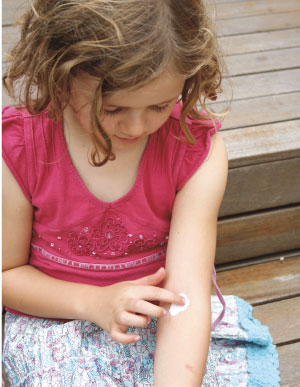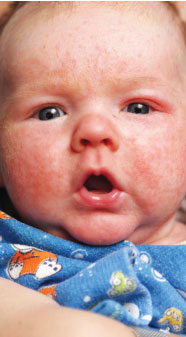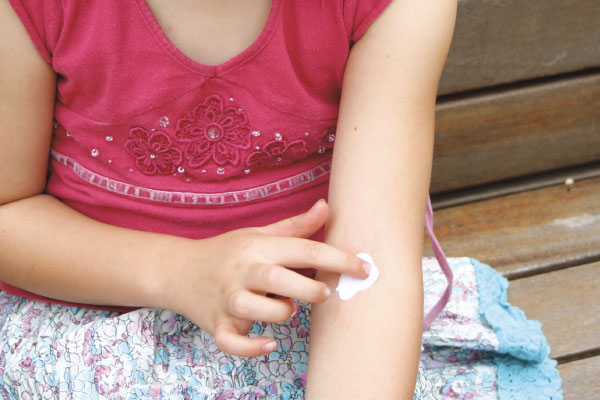Unfortunately, there is no cure for eczema. In most children, however, it becomes less severe with time. The good news is that the skin inflammation can be controlled.
 Eczema is a chronic itchy skin condition, which typically starts within the first five years of life and most often in the first six months. It classically lasts into childhood and adolescence. In certain cases it may last into adulthood.
Eczema is a chronic itchy skin condition, which typically starts within the first five years of life and most often in the first six months. It classically lasts into childhood and adolescence. In certain cases it may last into adulthood.
The inflammation tends to wax and wane. There are periods of time where the skin appears mildly affected or even normal, alternating with periods of moderate to severe involvement. Some children have very mild eczema, while others have severe eczema also known as atopic dermatitis.
Eczema inclines to be more common in families that have a history of the condition, hay fever and asthma. These disorders are all part of what is called the atopic triad. Children with eczema may be more likely to develop allergies or asthma, but one does not cause the other.
Based on age
The location and appearance of eczema changes as children grow. In young babies, eczema is most noticeable on the cheeks, forehead and scalp. It may affect most of the body but usually spares the diaper area.
At six to 12 months of age, it is often worst on the crawling surfaces, like the elbows and knees. Around the age of two, the distribution changes and tends to include the creases of the elbows and knees, the wrists, ankles and hands. It may affect the skin around the mouth and the eyelids. Older children and adolescents may have eczema only involving the hands.
When it attacks
Eczema flares occur when the skin is very dry or infected, or when it comes in contact with irritating substances or allergic triggers. It tends to be worse in the winter when the air is dry and tends to improve in the summer when it is more humid.
In babies, saliva from drooling may cause additional irritation, particularly to the cheeks, chin and neck. In such cases, applying an ointment like Vaseline can prevent direct contact with saliva and decrease irritation.
Very mild eczema may be controlled with a good bathing and moisturising routine. Mild eczema may require the occasional use of a low-potency topical steroid. The majority of children with atopic dermatitis will need to use low- to medium-potency topical steroids on a more regular basis to control eczema.
Wash it off
Daily bathing is recommended for infants and children with eczema. Baths are generally preferred over showers. They should be warm and not hot. They should be short in duration, lasting about 10 minutes.
The use of soap should be limited. Bubble bath, Epsom salts and other bath additives should be avoided because they can irritate the skin and worsen eczema. Avoid the use of scrubbers, loofahs and rough washcloths.
Bleach baths may be recommended by your dermatologist if your child has moderate to severe eczema and/or a history of infection. They can help control the amount of bacteria on the skin and lead to fewer skin infections. When the skin is infected, your physician may have to prescribe an oral antibiotic to alleviate the eczema.
Soothe the skin
Moisturisers should be applied at least twice a day in a thick layer. Generally, two types of moisturisers are recommended for treating eczema: ointments and creams. Lotions are mostly water and are not recommended.
It is important to moisturise the skin within three minutes of bathing to prevent evaporation of moisture from the skin. Encourage your child to participate in their skincare routine. Establish a reward system if necessary.
It’s not the food
Most infant eczema is unrelated to the diet, whether it is breast milk or baby formula. Many babies with eczema are incorrectly labelled as ‘milk allergic’. Do not stop breastfeeding or giving cow’s milk formula without first talking to your child’s physician.
While many parents assume that a particular food is the cause of their child’s eczema, the answer is rarely that simple. Parents who remove food from their child’s diet in an effort to clear up the skin can be causing more harm than good. If your child’s eczema greatly improves with gentle skincare and topical medications, it is improbable that there is a concealed food allergy in play.
Some children with eczema have food allergies, but that does not mean that they actually cause the eczema. Because most eczema is not related to the diet, and because current allergy tests do not accurately predict eczema triggers, allergy testing is not routinely recommended.
OINTMENT APPLICATION TIPS
 • Apply topical steroids only to rough affected skin and avoid normal unaffected skin.
• Apply topical steroids only to rough affected skin and avoid normal unaffected skin.
• Avoid the application of topical steroids to skin folds (armpits, groin, thighs, under breasts) when possible, particularly for extended periods of time.
• Avoid the use of topical steroids on eyelids.
• Apply milder steroids to treat the face.
• Use the mildest topical steroid that controls the eczema, which your physician can help you determine.
• Apply topical steroids no more than two times per day.
• One application should occur immediately after bathing as part of the bathing routine. A moisturiser should always be applied over the topical steroid.
• Be aware that the skin may look lighter in colour after the redness clears. This is normal and improves with time.





































